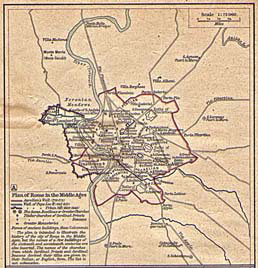Rome
Significance within the Decameron:
Stories:
Neifile: First Day, Second Tale (Abraham visits Rome and converts to Christianity)
Elissa: Fifth Day, Third Tale (Pietro and Agnolella elope and get lost in the forest)
Lauretta: Fifth Day, Seventh Tale (Teodoro and Violante fall in love)
Elissa: Tenth Day, Second Tale (tale of Abbot of Cluny and his stomachache)
Filomena: Tenth Day, Eighth Tale (Sophronia marries the wrong man)
Dioneo: Tenth Day, Tenth Tale (Marquis of Saluzzo marries a peasant and tests her)
Pertinent data:
Political Aspects: Being the host to the Vatican, Rome has always been a conservative city, with the Papacy exerting an almost iron grip over the city. After the Papacy moved to Avignon in 1308, Rome was beset with strife. Two major aristocratic families were feuding for control of the city, the Colonna and the Orsini. Cola di Rienzo, who attempted to restore the city to its previous republican virtue, was overthrown and killed in 1354.
Contemporary Issues: The religious orders housed within Rome were rife with corruption and sins of the flesh in Boccaccio's day. Boccaccio mentions the largess of the Catholic Church several times within the Decameron.
Images:
Image of Rome from the 15th century. Images of Vatican City, Rome above and here are all courtesy of Choate Rosemary Hall.
(J. K., J. Q. & N. F.)

